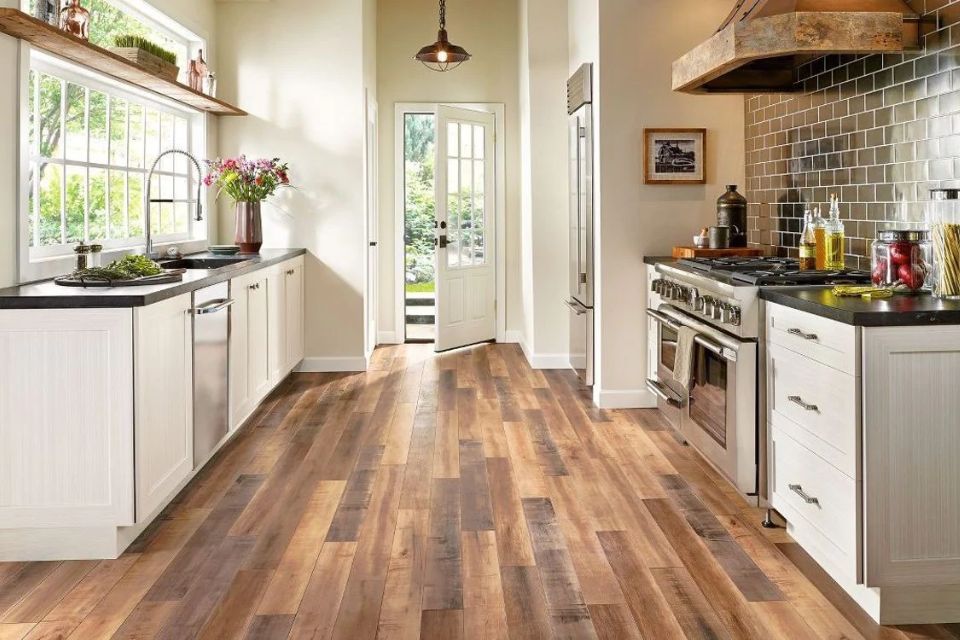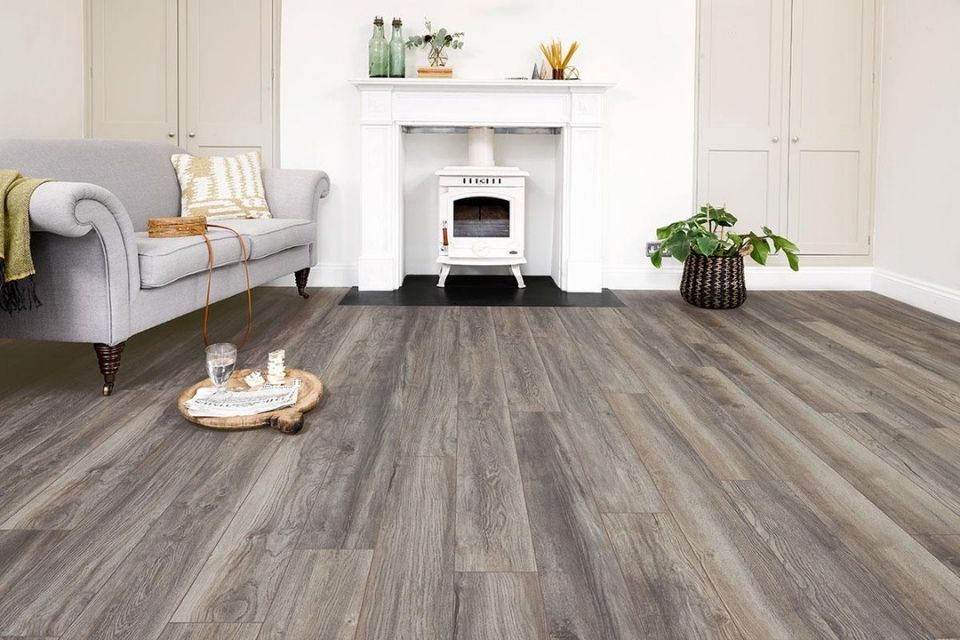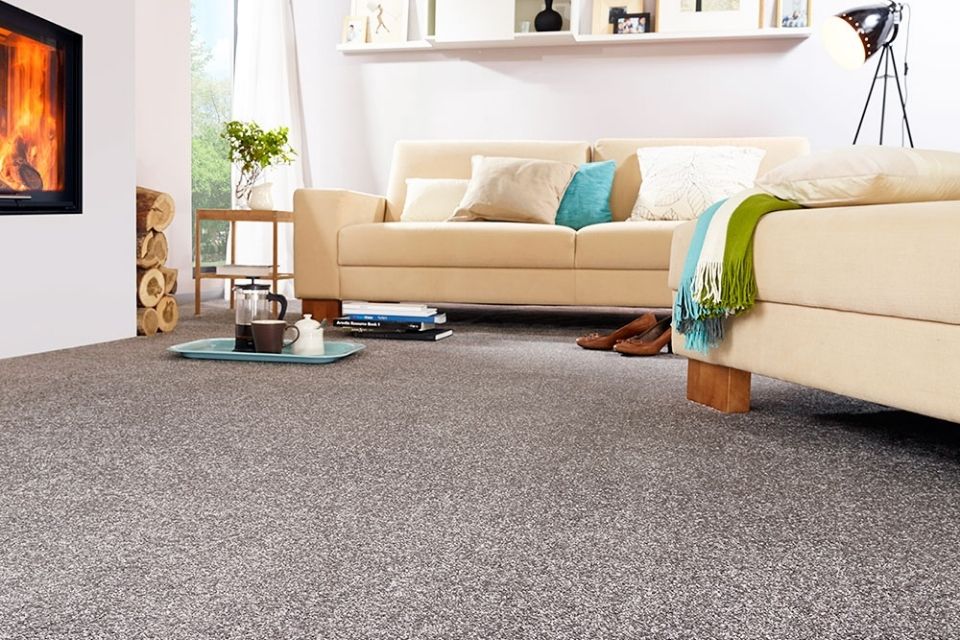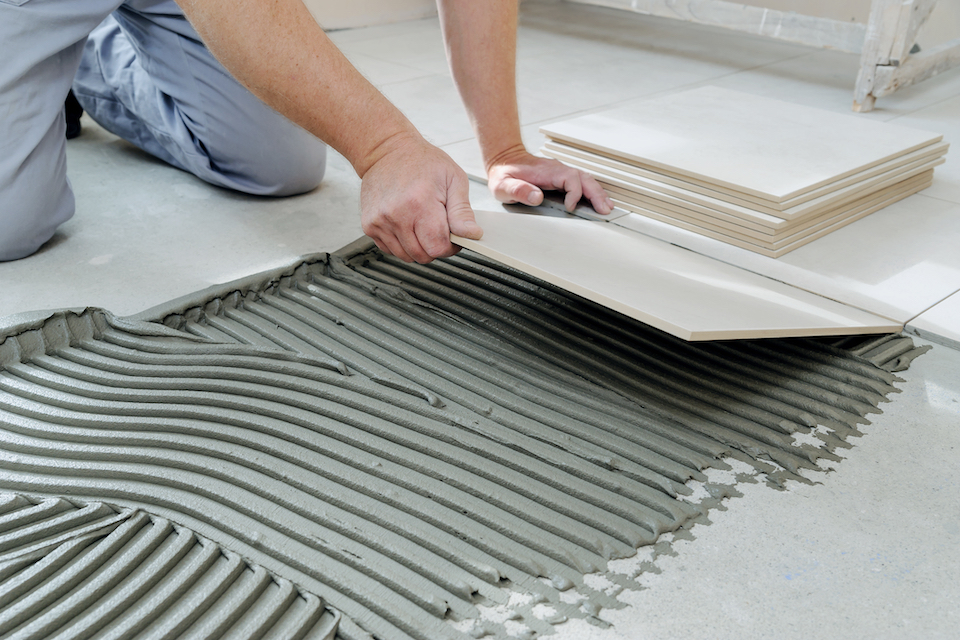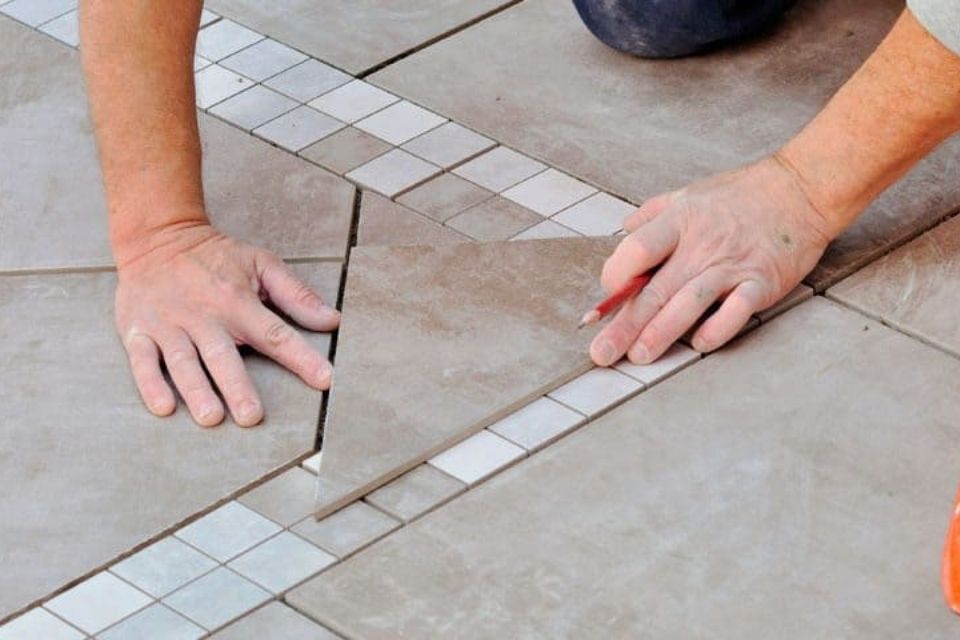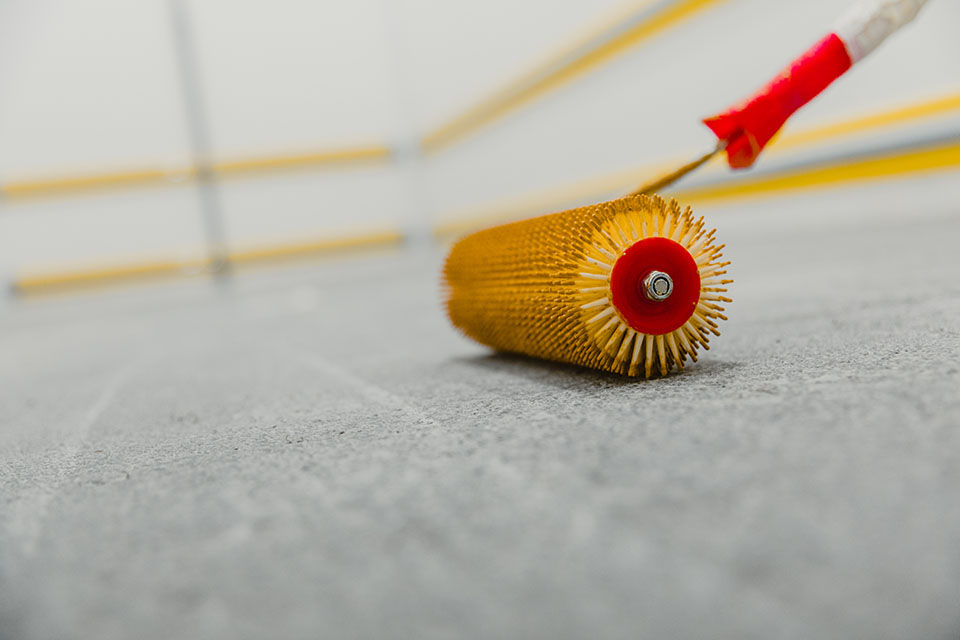Introduction to the Best Kitchen Flooring
When renovating your home, choosing the best option for your kitchen flooring can drive you up the wall. Of course we all want something that looks nice and fits the aesthetic of our home, however certain flooring can prove to be a bit of a blunder.
Choosing the correct flooring for your kitchen is extremely important, and should be done with careful consideration.
When choosing a material for your flooring, you want to find something durable that is very easy to remove stains from, with strong waterproofing.
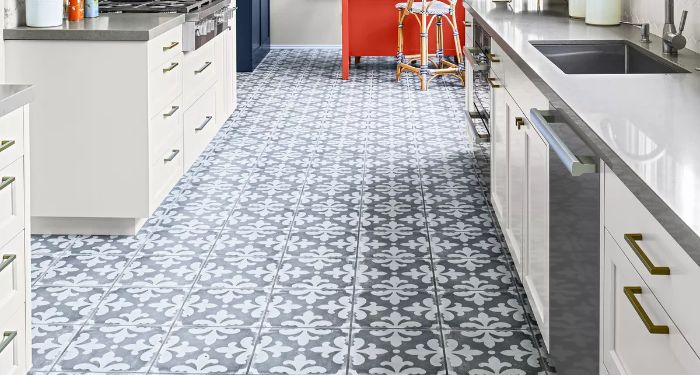
Kitchens tend to be the places where most accidents happen, whether that be smashing a glass, dropping your dinner or even a leaky appliance, so you want to make sure your floor can withstand the mess.
Choosing the wrong flooring for a kitchen setting can result in lifelong stains, scratches, water damage and more.
We’re going to be discussing the different types of kitchen flooring materials, what you should look for when investing in new kitchen flooring, and the costs of having flooring installed by a professional.
So if you’re in the midst of a home renovation, or treating yourself to a brand new cooking area - stay tuned!
What to Look for in Kitchen Flooring
When looking for flooring for your kitchen, you need to consider a number of things.
Due to this usually being the busiest - and most dangerous - area of the home, the materials chosen have to be able to tolerate many different factors and elements that it may come into close contact with.
The best solution to indecisiveness when choosing your kitchen floor, is to do a bit of research on whether the flooring you have in mind can handle the main hazards that happen in the kitchen.
Here are some of the most common factors that your kitchen flooring will need to withstand:
Moisture Resistance
Like the bathroom, the kitchen is a room in the home that is highly likely to suffer from excess water making its way onto the flooring.
Due to the high number of water based appliances and piping in a kitchen, it’s likely that you will experience a leakage at some point.
This could be from a damaged sink pipe, a failing washing machine or dishwasher, an accident with the kettle, or even just someone becoming a little clumsy whilst holding a glass of water.
For these reasons, the best option is to go with a type of material for your flooring that is fully waterproof.
Choosing the wrong kind of flooring could result in permanent water damage, and water staining that would require you to replace the floor.
Consistent exposure to water on incompatible materials could also result in the growth of mould and mildew, which could cause the flooring to rot over time.
For example, although laminate flooring looks clean and modern, it does not withstand water exposure very well. If you were to spill something or experience a leak onto a laminate floor, the water could soak in causing the flooring to become warped and damaged.
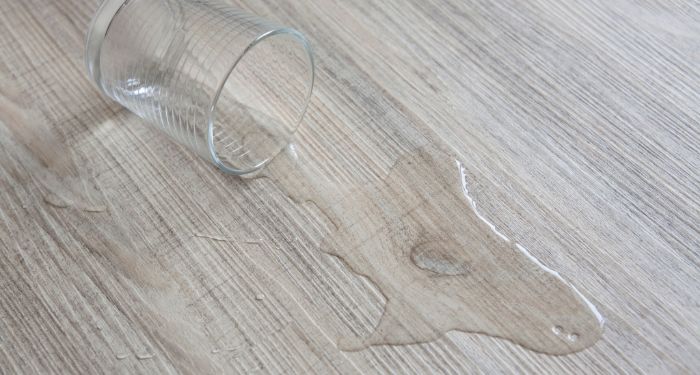
As well as ‘waterproof’ flooring, some flooring is labelled ‘water resistant’.
Although water resistance sounds like a great quality for your floor to possess, this is not enough for a kitchen. Where waterproof materials do not allow any water molecules to pass through the surface, water resistant materials are designed with a coating or substance that takes longer to absorb a liquid.
Therefore, if you returned from a holiday and a pipe had burst in your kitchen, a waterproof floor would be undamaged and easy to clean, whereas a water resistant floor would have slowly absorbed the water.
Laminate flooring, as we mentioned earlier, is a great example of this. It is amazing for small spillages that are cleaned up quickly, however constant exposure to large amounts of water would damage it, resulting in costly repairs.
Condensation is also a huge issue to keep in mind when deciding on which flooring to install. Any rooms with excess exposure to water can begin to mimic a sauna when heat is involved.
Have you ever noticed that when you get out of a hot shower, the mirror is foggy and the walls seem damp? Well it’s the same situation with your kitchen.
Heat Resistance
Due to the large amount of appliances in a kitchen, heat is a very important factor to consider when selecting flooring.
Kitchen flooring must be able to resist changes in room temperature, as well as being able to tolerate direct heat without damage.
The temperature of a kitchen is prone to dramatic changes while the homeowner is cooking, therefore the flooring has to be of a material that can withstand drastic temperature changes.
When you’re boiling a kettle, boiling vegetables, or using your stove to cook, the excess water evaporates into the air and settles on objects around it, causing them to become damp.
Although this condensation can be easily resolved with the likes of an extractor fan or an open window, it’s best to select a material for your floor that can cope with a humid environment.
The wrong flooring paired with excessive water vapour is a one way ticket to damp, mould and costly repairs.
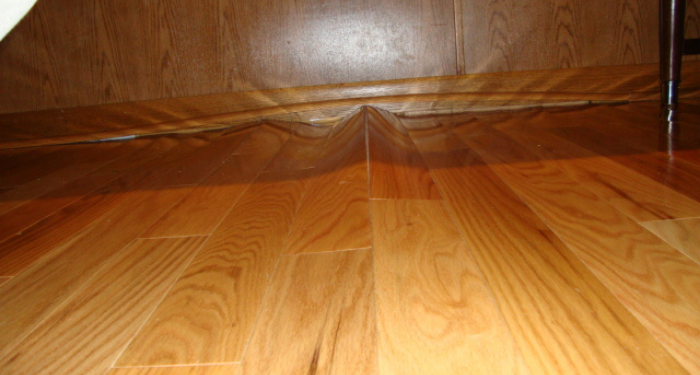
Kitchens are also the room in a home that is most likely to come into contact with fire, so it’s extremely important that the flooring you install is as fireproof as possible.
You need to ensure that the flooring you choose does not ignite and burn easily, does not spread the fire very far, and does not produce mass amounts of smoke when it burns.
Stain Resistance
Spillages are a large issue when it comes to kitchens, due to the large amount of baking, cooking and so on.
If you spill a glass of red wine, a tin of tomato soup, or have an accident with the flour, you want to be able to easily clean it up.
The problem with some floors is that they are porous, and tend to soak up any solution that has been spilt. Materials such as concrete, and some softer surfaces are a lot more porous than others, therefore they may soak up liquids faster resulting in permanent stains.
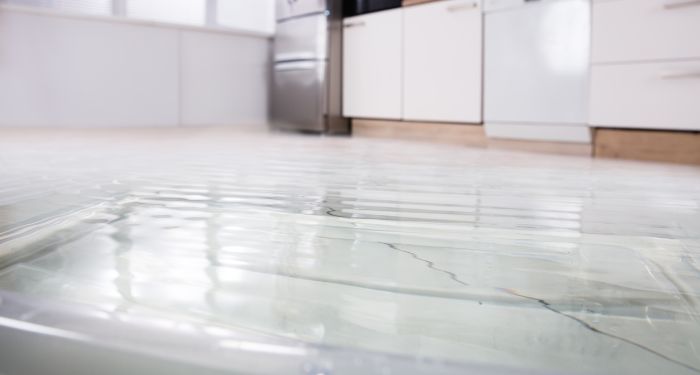
Even hardwood flooring, which has been branded one of the most durable options for kitchens, can have a severe issue with staining which can be very difficult and costly to resolve.
Although cleaning up the spillage straight away can be a great method of tackling this issue, depending on the substance that was spilt there may always be some residue that has already stained the floor.
More solid flooring options such as dark slates are great to avoid stains, as they are very resilient to substances. They can become stained due to water spillages and calcified deposit stains, however this is very easy to clean.
Impact Resistance
We all have that family member who can’t open a cupboard without smashing a plate. Or that flatmate who hoards glasses in their room, and juggles them back to the kitchen on a weekly basis.
If an accident is waiting to happen, the kitchen tends to be the most likely room in the home for it to occur.
When looking through your flooring options, durability should always be one of the main factors to consider.
You want to choose a flooring material that can withstand dropped pots and pans, fallen sharp objects, smashed plates and glasses, and the odd tumbling appliance.
Basically - the tougher the floor, the better.
Softer flooring is not very capable of tolerating excess weight or sharp objects hitting it at high speed.
Installing flooring in your kitchen with softer materials can result in damages in the future, that can completely ruin the aesthetic of the room and can be a nightmare to fix.
The flooring you install in your kitchen should be something that is going to last a long time, without the need for much maintenance.
Materials such as kitchen laminate flooring are easily bumped and scratched, and shouldn’t be chosen for kitchen use.
If you’ve ever tried to move a wardrobe or cupboard across a laminate floored room and ended up with a scratch or two, you’ll understand what we mean.
Best Types of Kitchen Flooring
There are many different options when choosing flooring for your kitchen, and quite often it can be completely overwhelming.
We’ll be discussing a few of the most popular go-to kitchen flooring ideas and options when looking to renovate their kitchen, and providing a number of advantages and disadvantages for each one.
Tile Kitchen Flooring
Tiles are extremely common for those rooms that can be exposed to excess water, such as the kitchen and bathroom.
They are one of the most popular flooring options when renovating a kitchen space, but are they the most effective?
There are a number of different materials of tile, and depending on which one you choose it could go both ways. Cheaper tiles are very susceptible to chipping and cracking when things are dropped onto them.
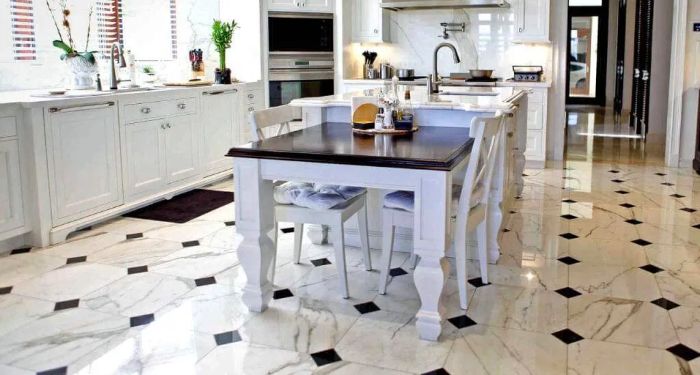
So if you’re thinking of fitting tiles to your kitchen floor, invest in something a little more pricey like ceramic, porcelain or stone.
Ceramic Tiles
Ceramic tiles, including porcelain, are extremely durable, and are a viable option for kitchens.
They are manufactured through extreme temperatures, so they are able to withstand both the heat of cooking and direct heat from potential kitchen fires.
Ceramic tiles are very long-lasting, and over long periods of time their appearance and colour does not seem to change much, meaning they are a great ‘maintenance-free’ option for homeowners.
You can find ceramic tiles in a multitude of different colours, patterns and designs to match the aesthetic of your home accordingly, making them extremely versatile for those adventurous buyers.
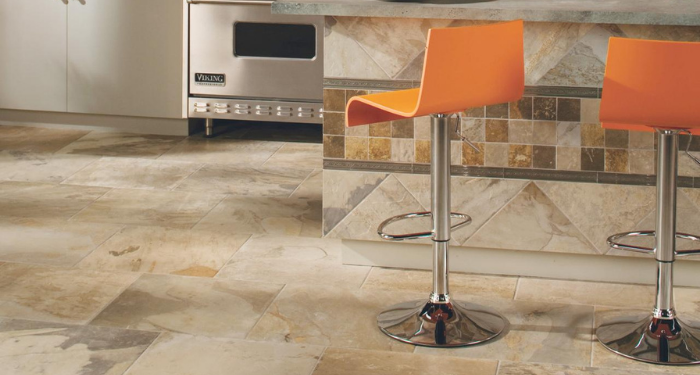
Ceramic tiles are perfect for wet environments, because although they do have a tendency to absorb water slightly, they are not damaged by water. Making them the perfect choice for your kitchen or bathroom floor.
Although ceramic tiles are meant to be resistant to staining, staining can appear from other household objects and appliances. The plus side to this is that the stains are easily cleaned with the use of the correct cleaning agents.
The most common complaint about ceramic tile flooring is how cold it can make a room feel, and how cold it can feel on your feet.
This can be fixed with the usage of underfloor heating if you so desire, however installing a heating system isn’t within everyone's price range.
Ceramic tiles typically cost between £20 to £30 per square metre.
Pros:
- Ceramic tiles are extremely durable.
- Ceramic tiles are waterproof.
- Ceramic tiles and lower porosity stone tiles are not easily stained.
Cons:
- Tend to be very cold.
- Very hard surface.
Natural Stone Tiles
Natural stone tiles are another great option for kitchen use. Due to it being made from real stone, it is one of the most durable options on the market.
There are many different types of stone tile to choose from, depending on what look you’re going for.
Some great options are:
- Slate
- Limestone
- Granite
- Marble
- Sandstone
It completely depends on which type of stone you choose as each stone has different properties, which give them advantages or disadvantages to the rest.
Out of the ones we listed above, slate and granite are the most durable, meaning that with the correct maintenance they can last for decades - which is something most homeowners are looking for.
Marble is an extremely popular option for those going for that higher end, luxury feel, however unfortunately, marble tiles tend to be the least durable of the bunch.
Sandstone is in the middle ground, as it will wear down over time however not as fast as some of the others.
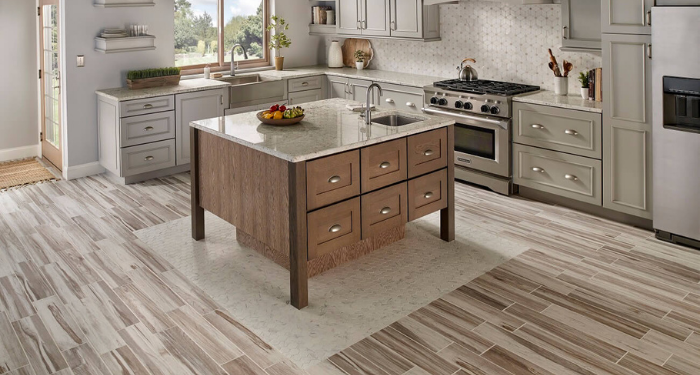
Another downside to natural stone is that it tends to be easily stained, due to the porosity of it. Depending on the stone you use you will receive different results.
If you choose slate or marble, you will have a lot less issues with porosity than if you choose something like limestone or sandstone as they are of a lot more sturdy build.
With regular touch ups of an appropriate sealant this can be avoided.
Most natural stone is great for use in rooms which may have a higher possibility of direct contact with fire, as they are flame resistant.
Natural stone tiles typically cost between £25 to £35 per square metre.
Pros:
- Slate and granite tiles are extremely durable.
- Can be pricey.
- Fire resistant.
- Heat resistant.
- Some stone tiles are water resistant.
- Easy to clean.
- Very versatile, lots of colours available.
Cons:
- Marble, sandstone and limestone can wear away over time.
- Some stone tiles can be quite porous.
- Higher porosity stone can be easily stained.
- Tend to be very cold.
- Very hard surface.
Solid Wood Kitchen Flooring
Solid wood flooring, otherwise known as ‘hardwood’, has been around for a long time as a staple in many homes.
It’s been debated whether it should be used for wet environments such as kitchens and bathrooms, as it's generally known as a more porous material in comparison to others.
However due to the usage of new sealants and solutions to create a water resistant finish, it is becoming more popular in these areas.
After using sealants hardwood can be a viable option for a kitchen floor, however keep in mind that sealants will only make the flooring water resistant and not fully waterproof. Therefore wood flooring for kitchen use is still susceptible to water damage if a leak occurs.
The sealants however, will make the flooring much more durable and long lasting, which means that as long as the correct maintenance is carried out it should be around for a while.
Hardwood flooring is porous, so without correct usage of sealants it can be stained by spillages and such. Even with the use of sealants, staining can still occur.
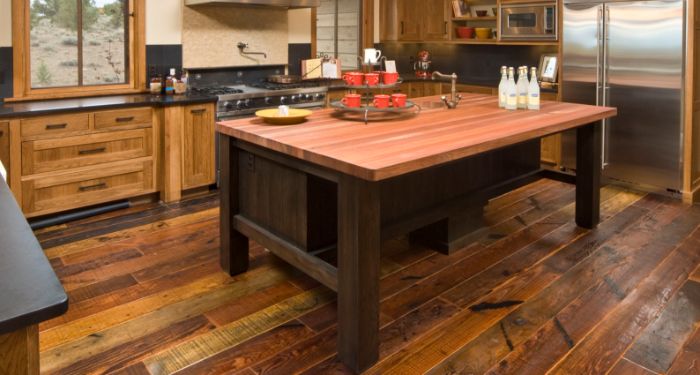
However, the best part about hardwood flooring is that instead of replacing the entire floor, you are able to sand down the surface, and seal it as good as new!
Although we often think of wood as the perfect material for burning, this is only certain types of wood.
Woods used for hardwood flooring are actually quite fire resistant, as they hold water within them, which can slow the spread of a fire. Especially when sealants are added to protect the wood, fire has an even harder time surviving.
Hardwood flooring is also easy to clean, after sealants have been applied correctly, providing the spillage is cleaned up in a timely manner.
Solid wood kitchen flooring typically costs around £30 to £70 per square metre.
Pros:
- A traditional material used in homes.
- Water resistant.
- A good fire resistant material.
- Easy to clean.
- Durable.
- Can be sanded down and resealed, good as new.
- Sealant adds an extra layer of protection.
Cons:
- Can be pricey.
- Can be stained - stains aren’t easy to remove.
- Porous if sealant isn’t correctly applied.
Laminate Kitchen Flooring
Laminate flooring is extremely popular in modern homes, and new builds. This is mainly due to the fact that it is a lot cheaper and easier to install than other materials. However, a more cost effective floor doesn’t always mean a better floor.
We’re just going to say it: Laminate flooring is not a great fit for kitchens. Although it looks clean and fits an uncluttered, modern aesthetic, it is extremely porous.
Laminate kitchen flooring has a bad habit of soaking up anything that leaks onto it, making it great for living rooms and hallways but a terrible idea for wet environments such as kitchens and bathrooms.
A small spillage can be extremely easily cleaned, but as soon as something larger happens, such as a broken washing machine spilling out onto the floor you’re doomed.
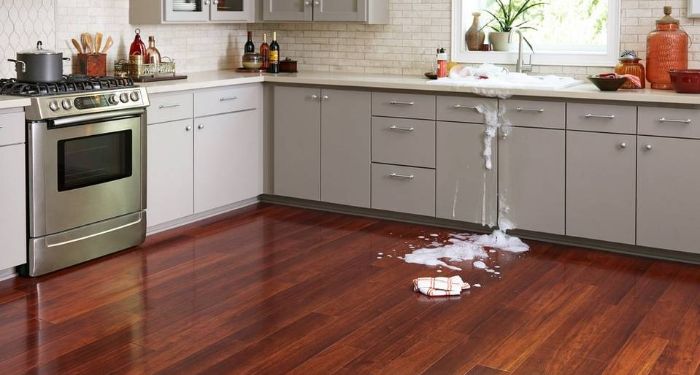
Laminate flooring soaks up liquids a lot faster than other materials, and if this happens constantly the surface of the flooring can become extremely warped and damaged.
It’s another case of the material only being water resistant, and not at all waterproof.
On the other hand, laminate flooring can be fixed easily, as it is essentially just slotted together by a professional. However, laminate flooring doesn’t tend to stick around in the marketplace for very long.
More updated versions tend to be released every few years, and old versions discontinued. Meaning that if a few years have passed, you may not be able to find the same design and you may have to start again from scratch.
Laminate flooring is also not very durable at all, it becomes scratched and bumped extremely easily. So if you have a clumsy habit of frequently dropping your cutlery and appliances, this ones not for you.
This type of material has been designed to be fire resistant, however it’s not as fire resistant as some other types of flooring.
However, despite all of this, laminate flooring is extremely easy to clean - just don’t use too much water to do so!
Laminate kitchen flooring is typically priced at £20 to £30 per square metre.
Pros:
- Cheaper than most flooring.
- Very easy to install.
- Fire resistant to an extent.
- Easy to clean.
- Easy to repair.
Cons:
- Extremely porous.
- Easily damaged, bumps and scratches.
- Very easily damaged by water.
- Hard to find replacement boards if it’s been more than a year or two since floor was fitted.
Carpet Kitchen Flooring
Out of the many kitchen flooring options, carpet is definitely the worst of the kitchen flooring types you could choose.
Carpet used to be extremely popular for bathroom flooring and such, back in the day. If you visit your grandma's home, you may even still find one there!
However, we have moved on with technology and design, and have learnt the hard way that carpets in the wrong area of the home can be disastrous.
Carpet flooring is possibly the most absorbent and porous kind of flooring that exists, meaning that absolutely anything you spill on it will be sucked right up.
This makes cleaning an absolute nightmare, especially when the substance spilt is a big glass of red wine.
Although you may be thinking about the comforts of having wool under your feet, those home comforts won’t last very long.
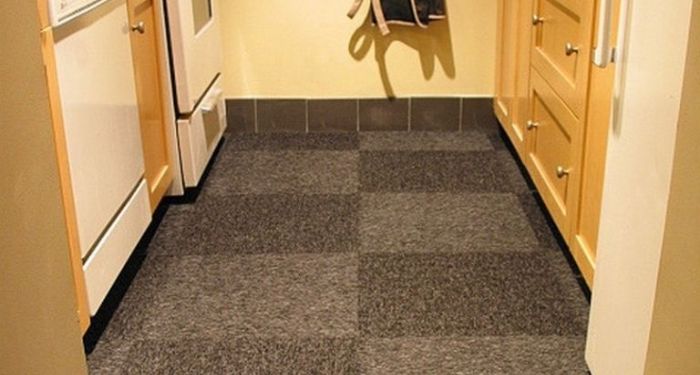
Carpet is usually quite durable in its usual environment - the living room, however it would become easily stained and unbearable to clean in the kitchen.
Contrary to most beliefs, carpet is actually quite fire resistant. Most carpets are designed to extinguish small flames in around a minute, however we’re still not confident that they’re a safe bet for your kitchen.
Not to mention the condensation usually produced while cooking would mean your flooring would get damp continuously, causing mould, and rot.
Pros:
- Fire resistant to an extent.
- Easy to install.
- Comfy.
Cons:
- Easily stained.
- Extremely porous.
- Highly likely for mould and rot to occur.
- Not easy to repair.
- Not easy to clean.
- Easily damaged.
You should expect to pay around £5 to £40 per square metre for carpet.
Vinyl Kitchen Flooring
Out of all the flooring options we’ve discussed, vinyl is our favourite and definitely the best kitchen flooring option available. Vinyl has been around a long time, and was extremely popular in the 70s and is still widely used in today's homes.
Quite often people think about vinyl and experience a flashback to that dated, patterned kitchen vinyl flooring in the strangest of colours. However, vinyl flooring has come an extremely long way since then!
There are so many options to choose from, it’s possibly the most versatile flooring option out there.
So whether you’re going for a modern, minimalist look, a tiled look, or something a bit more out there, there’s always something to match your aesthetic.
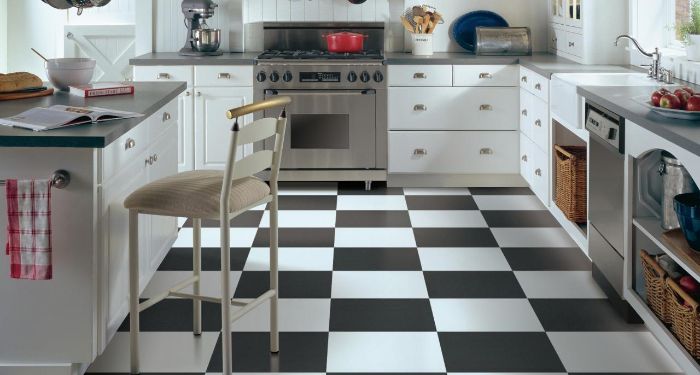
Most vinyl comes in flexible sheets that are easy to install professionally, and easy to DIY.
However if you were looking for something a little more luxury, vinyl also comes in planks that mimic wood, laminate flooring and much more.
So if you were determined on that laminate flooring for your kitchen, look no further.
Vinyl flooring is the cheaper option when it comes to kitchens, and it’s incredibly easy to install. It’s durable, and almost completely resistant to stains, water damage and other types of damage.
It’s extremely easy to clean - all you need is a bit of a hoover and a good mop - and it’s both waterproof, and fire resistant. What more could you ask for!
Vinyl is also incredibly easy and cheap to take up and redo if you’re getting sick of the pattern, or it’s looking a little worse for wear.
Some warranties state that vinyl can last up to 20 years, however on average it tends to start looking a little worn down after around 7-10 years.
Vinyl kitchen flooring tends to cost about £15 to £25 per square metre.
Pros:
- Extremely cheap.
- Very durable.
- Easy to install.
- Easy to DIY.
- Very versatile.
- Has more luxury options.
- Can mimic other types of flooring but for better value.
- Waterproof.
- Fire resistant.
- Almost damage proof.
- Easy to clean.
Cons:
- May not last as long as other flooring options.
Engineered Wood Kitchen Flooring
In comparison to other wood flooring options, such as solid wood, engineered wood is the better choice for a kitchen environment. Engineered wood is designed with multiple layers which helps it to withstand changes in moisture and heat in the environment.
Engineered wood is not waterproof by any means, but due to it being more manmade than hardwood flooring it is definitely more water resistant.
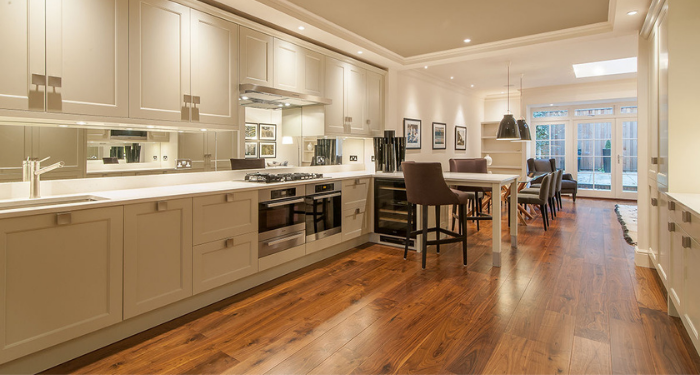
It’s also a much more affordable option to solid wood flooring, making it a better option for those on a budget. It’s easier to install than solid wood flooring, however it may not last as long.
Although on the other hand, with the extra layers of stability it’s a better option for kitchens due to it being able to resist water and heat more efficiently.
It’s easy to clean, any spillages can be mopped up in a jiffy without worrying about the spillage or the water warping the surface.
The average cost of engineered wood kitchen flooring is around £18 to £70 per square metre.
Pros:
- Water resistant.
- Fire resistant.
- Manages heat changes well.
- More affordable than hardwood.
- Versatile.
- Mimics a normal hardwood flooring - shouldn't be able to tell the difference.
- Easy to clean.
- Durable.
- Not easily damaged.
Cons:
- Not fully waterproof.
- May not last as long as solid wood flooring.
Cost of Installing Kitchen Flooring
Before installing your kitchen, it’s great to know the costs of everything.
Different types of kitchen flooring come at a range of different costs for a professional to install, and most aren’t feasible on a DIY basis. The cost of replacing kitchen floors are as follows:
Tile Flooring Cost
If you’re looking at installing kitchen tile flooring, you’re going to need a tiler. As of 2020, the average cost for a tiler to fit floor tile is around £600-£700 in total.
Most tilers charge around £150-£200 daily, however more expensive areas such as London may charge more to install.
It is possible to install tile flooring yourself, but with all the work of lifting the current flooring, removing the skirting boards, and prepping the area to be tiles it may be easier in the longer run to hire a professional.
Wood Flooring Cost
When deciding on a solid wood floor, you’re going to need a wood flooring specialist. The cost of wood flooring is on average around £1300 for a medium sized room.
Daily rates for wood flooring specialists are on average £150 a day.
Laminate Flooring Cost
Laminate flooring is a lot cheaper, coming in at around £600 to install in an average sized room, and engineered wood pricing averages in between the two, as it’s a more sturdy material than laminate but not quite as durable as woods such as oak.
Laminate flooring costs on average £1-£3 per square foot.
Carpet Flooring Cost
Carpet is a tricky one to find an average price for, due to many different factors that can affect the pricing.
The type of carpet you’re wishing to install can greatly affect the pricing, depending on if you’re going for something budget, middle-ground or more luxury.
Pricing can also depend on the size of the room and what type of room you are having carpet fitted in. Stairs and living rooms, for example, would be very different costs.
Carpet is one of the quicker flooring options, taking around 3 hours to install with the added time of moving furniture and preparing.
The average price for a carpet fitter to install a carpet is around £90-£120, not including the costs of the materials themselves which come to an estimated £400.
Vinyl Flooring Cost
Vinyl flooring specialists on average charge around £300 to install vinyl flooring to an average sized room.
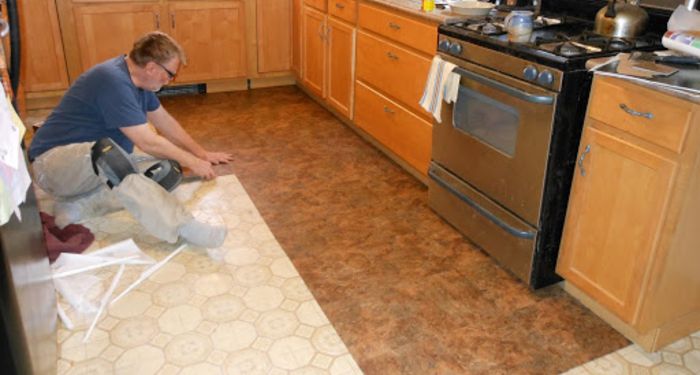
The average tradesperson will usually charge around £15-20 per hour for their work, however this depends on the city you are living in.
Vinyl flooring is extremely quick to install, only taking around a day to fully fit.
FAQs
Q. What is the best option for kitchen flooring?
A: The best flooring for kitchens in terms of flooring that fits the categories of being safe for kitchen use (fire/heat resistant, waterproof, damage resistant), are vinyl, tiles, solid wood and engineered wood.
Out of the bunch, vinyl and tiles are the better options, engineered wood comes in strong second place and solid wood makes it at third runner up due to it being less resistant to water than the other options.
Q: What is the cheapest option for kitchen flooring?
A: If you’re looking for a budget flooring that comes in a range of styles and designs, and is easy and cheap to install, vinyl is your best bet.
Vinyl materials are the cheapest flooring option, and they are extremely compatible with kitchen surroundings.
Q: What type of flooring takes the least time to install?
A: Out of all of the options, carpet wins the race of being the quickest flooring to install - taking only 3 hours on average.
Of course, you will need to factor in the preparation and clean up time, which includes moving furniture.
Q: Is all flooring fire resistant?
A: Most flooring is made to be fire resistant to some extent, however not all floorings are equal in this department, especially when it comes to kitchens.
For a room which is highly likely to be exposed to heat and direct flames, something like tiles, vinyl or even wood would be your best bet.
We would advise not putting carpet on the list, even if it does state it is fire resistant.
Q: What is the most waterproof type of kitchen flooring?
A: The most waterproof type of kitchen flooring is definitely either tiles or vinyl. Both have the amazing ability of repelling water, and are extremely easy and efficient to clean.
Other types of flooring such as laminate and solid wood can become warped over time when exposed to water, and carpets are very prone to mould and rot when damp.
Sources
- https://www.sinaarchitecturaldesign.com/2018/12/best-worst-flooring-options-kitchens/
- https://www.kunststofvloer.info/en/specials/hittebestendige-vloeren/
- https://www.flooranddecor.com/help-center/product-questions/help-product-tile/hc-is-tile-waterproof.html
- https://woodpeckerflooring.co.uk/professional/blog/5-things-to-consider-when-specifying-kitchen-wood-flooring/
- http://blog.flooringvillage.co.uk/is-engineered-wood-flooring-waterproof/

